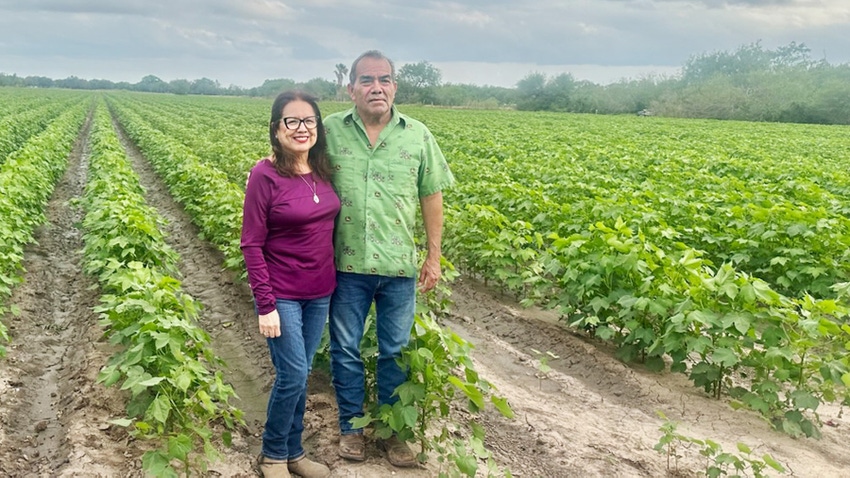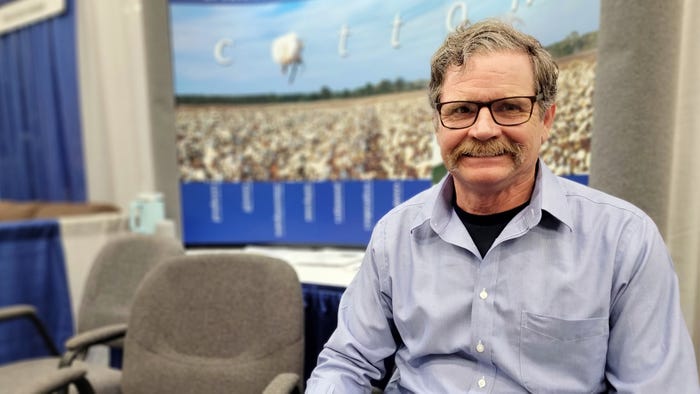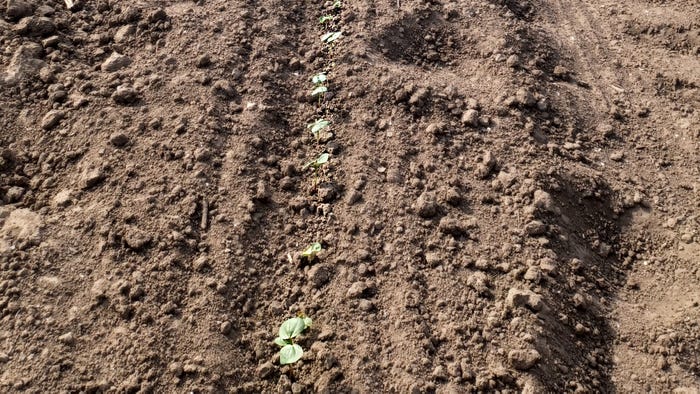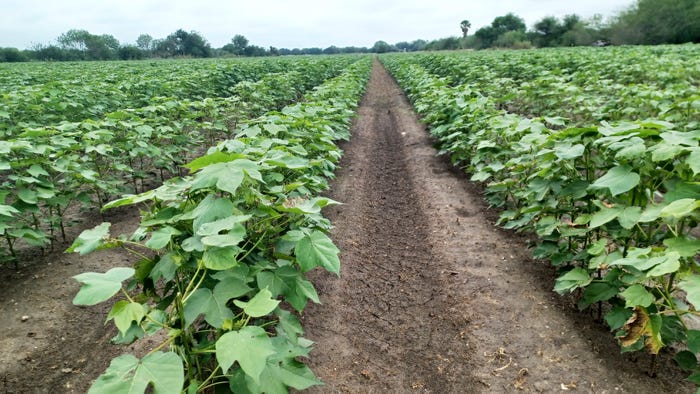
Planted cotton acres throughout South Texas are down compared to 2022. From weather to water to input costs and the markets, several factors have influenced the region’s planting decisions. Farm Press caught up with Dwight Jackson, National Cotton Council member services representative, to review the numbers.
In the Lower Rio Grande Valley, planted acres are down about 30% this year, from 182,000 acres in 2022 to 137, 000 acres, Jackson reported.

Dwight Jackson, National Cotton Council member services representative (Photo by Shelley E. Huguley),
“Water is being rationed from the Rio Grande River and farmer allotments are way down,” Jackson said. “They have to use what they get for crops like sugarcane, citrus, or other crops, so there’s quite a bit of irrigated cotton that won’t be planted in the Valley.”
Dryland acres are off a bit as well. “There’s some that was planted where the moisture was favorable, and they got a rain the last week of March.”
The region’s insurance planting date is March 31. After the recent rainfall, he said more acres were planted. “Towards the middle of March, we were only at about 110,000 acres. Last I heard, it was 131,000.”
Of the acres planted, Jackson said the crop is off to a good start. “The crop is from just coming up to beginning to bloom.”
Mercedes
Heron Castillo, a Mercedes, Texas, producer said he planted less irrigated cotton this year. “We’ve been in a drought for a long time in the Valley,” Castillo said. “We call it a drought because it doesn’t rain like it used to.”

Heron and Julie Castillo's cotton was planted Feb. 8. This photo was taken March 2. (Photo by Dwight Jackson, NCC)
Castillo, who is also a custom harvester, farms about 600 acres of cotton, milo and onions. His region didn’t receive moisture during onion season (October through April), forcing him to cut back. “I didn’t plant anymore acres because I needed to make sure I had enough water,” he said.
What water he and other LRGV producers don’t receive from Mother Nature is purchased through their local water districts. Allotments are limited, Castillo says. Producers can also purchase water credits from other districts.
“There’s people who own properties (in other districts) that don’t use water and then they sell it,” he explained. But it isn’t cheap. Locally, Castillo pays $15 per acre. When he purchases water credits from neighboring districts, he’s paid anywhere from $30 to $50 per acre. “It’s been costly to buy water.”
Irrigation water is released to LRGV producers from monitored water sources known as the Rio-Grande River Basin Reservoirs, which include lakes Amistad and Falcon. These water sources straddle the Texas-Mexico border. Water released between the two regions is regulated through the Mexican Water Treaty of 1944.
According to the Texas Water Development Board website, “By treaty, Texas has rights to 56.2% of the total conservation capacity of Amistad and 58.% of Falcon.” Currently, Lake Amistad is only at 33.9% capacity, while Falcon is at 22.3%.

The Castillo's cotton as of April 3. (Photo by Dwight Jackson, NCC)
While drought is partially to blame, both Castillo and Jackson agree, there’s a bigger issue. “Mexico’s adhering to it (the treaty) but they are not releasing the water timely,” Jackson said, adding they have five years to release a predetermined amount.
“They hold a lot water,” Castillo added. “It’s very frustrating. It affects everything -- your yield, your business, your income, your finances.”
Castillo, who plants on 40-inch rows, planted his DeltaPine 1646 cotton Feb. 8. “I ended up with a skippy stand in some parts but then we got a 3-inch rain. I went in there did some touchups.” Overall, he says his cotton came up nicely.
Corpus Christi
West of Corpus Christi, Jackson says producers were in “dire straits” until the region received some rain the first week of April. “We were looking at pretty good abandonment until then. That crop was made on that rain. It was either dry planted or trying to come up.
The insurance planting date for Corpus Christi is April 15. Jackson said April’s early rain shower “really helped out. Unfortunately, rains late last week have overcorrected the situation bringing a little hail and quite a bit of flooding. The crop is behind and today rotary hoes are beginning to pick their way through young fields.”

The Castillo's cotton as of April 24. (Photo by Dwight Jackson, NCC)
On the east side of Corpus, up against the Gulf from Corpus Christi north, Jackson said that region’s cotton emerged and looked “okay,” but at the end of April, they received some “big rains” that included hail. “So, we do have some drown outs and we’re looking at some replanting.”
Compared to 2022, Jackson estimates the dryland acres are off 10% to 15%.
In the Winter Garden, the irrigated cotton is expected to be “way off.” Probably, about 30% to 40%, he said.
Upper Coastal Bend
In the Upper Coastal Bend, which encompasses Refugio to everything below I-10, Jackson said, his sources tell him planted acres are down about 30% or more. “I don’t know if it’s going to be quite that bad because there’s some sweet areas, southwest of Houston, that aren’t going to be that bad.”
The Upper Coastal Bend is “mostly planted and looking good,” he added.
“This whole side of the state got rain the last two weeks (of April), so, with few exceptions, we’re wet everywhere. The crop was struggling to come along and now the corn’s chest high and the cotton’s squaring.”
Blacklands
North of I-10 up to Waco in the Southern Blacklands, planted cotton acres are expected to be off 30% or more. “And they’re probably 70% to 80% planted,” Jackson said.

Cotton is blooming on Heron and Julie Castillo's farm near Mercedes, Texas. (Photo by Dwight Jackson, NCC)
In the Northern Blacklands, from Temple north to the Oklahoma border, about 60% of the crop is planted. Similarly, planted acres are expected to be down at least 30% as well.
The reduction of planted acres throughout southern Texas has been influenced by the weather or water but other factors as well. “Undermining all this is input prices and the price of cotton,” Jackson said. “It’s not just the weather. The insurance price is lower. Basically, it’s the price of cotton compared to input costs.”
About the Author(s)
You May Also Like






